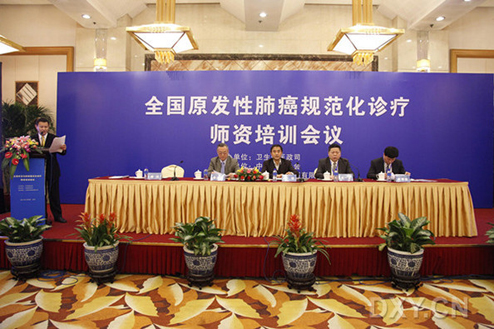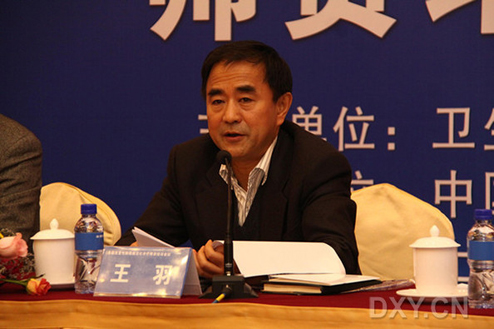On December 6, 2011, a meeting for national training program on standardized diagnosis and treatment of primary lung cancer was held in Beijing by Ministry of Public Health, the People’s Republic of China. This meeting, in line with the demands of health care reform in China, was a substantial step towards improving the current clinical practice in lung cancer management in China. The further standardized clinical diagnosis and treatment is expected to remarkably enhance therapeutic efficacy and economize medical resources so that patients can really enjoy safe, efficient, convenient and affordable medical services. Mr. Wang Yu, Chief from the Medical Policy Department, Ministry of Public Health, attended the meeting, delivering an important speech. Ms. Yao Hong, Director of the Chinese Hospitals Association, chaired the meeting which was to formally trigger the “National Training Program on Standardized Diagnosis and Treatment of Primary Lung Cancer”.

Fig 1. A scene of the meeting for National Training Program on Standardized Diagnosis and Treatment of Primary Lung Cancer
Primary lung cancer, one of the most common malignancies, tends to rise year by year in incidence and mortality, Mr. Wang Yu said at the meeting. According to the Statistical Yearbook of Ministry of Public Health 2011, among all the malignant tumors, primary lung cancer has risen up to the first place from the third in 1992 in mortality. The situation is very severe with a rising trend of mortality. It is obligatory for medical professionals, as well as for the government, to take comprehensive measures, early diagnosis and standardized treatment of lung cancer in particular, to ease the severe situation. Consequently, this is also a task for us to promote public health and build a socialist harmonious society.

Fig 2. Mr. Wang Yu, chief from the Medical Policy Department, Ministry of Public Health, delivering the opening speech.
Mr. Wang Yu pointed out that the communist party and government always pay close attention to the prevention and treatment of cancers for the people. The Medical Policy Department, Ministry of Public Health has done a series of highly effective jobs over the recent years. First, a system of standardized diagnoses and treatments for serious and fatal diseases, including tumors, has been under progressive construction. Second, management and control of medical quality has been strengthened. Third, training programs regarding prevention and treatment of tumors have been carried out. Fourth, a national case registration system of common tumors has been initiated. All these measures contribute to the enhanced overall capability and proficiency of clinical diagnosis and treatment of malignancies in China.
In spite of the accomplishments we have achieved, Mr. Wang Yu stressed, we should be clearly aware that we still have a long way to go in China to standardize diagnosis and treatment of malignant tumors. For one thing, the rising national incidence of tumors poses a serious threat to the public health. For the other, expensive medical costs incurred by tumors have become too heavy a financial burden for the patients, and the society as well, to bear. Health administrations of the governments, academic organizations, medical institutions and staff and other social sectors should make joint efforts to address these problems. More importantly, the problems can only be resolved once and for all by deepening the social reform of current Chinese system of public health care. Specifically, medical professionals for tumor management should, for the advantages of tumor victims, strictly follow the Guidelines for Diagnosis and Treatment of Primary Lung Cancer in designing the clinical protocols suitable for specific patients, reasonably use medical facilities, and administer effective and cheap medications. In a word, they should not only ensure clinical efficacy but also reduce reasonably medical expenditures.
Mr. Wang Yu asked for adequate awareness and thorough understanding of the significance of the meeting. Global coordination and regular training are needed to improve the current diagnosis and treatment of serious and fatal diseases, including lung cancer. An evaluation system should also be established and improved gradually for standardized diagnosis and treatment of tumors. Guidelines for Diagnosis and Treatment of Primary Lung Cancer should be implemented and popularized to normalize the whole process of diagnosis and treatment of the condition in the respects of diagnostic technique, pathological evaluation, surgical procedure, medical management, chemotherapy and radiotherapy.
Public health administrations in each province should organize and coordinate the training program on standardized diagnosis and treatment of primary lung cancer. They should also conduct, step by step, long-term management of standardized diagnosis and treatment of tumors to better their management and control of medical quality in all, and the diagnosis and treatment of primary lung cancer in particular.
Ministry of Public Health entrusted the Chinese Hospitals Association with organization and implementation of this program.
About 200 attendees were present at the meeting, including chiefs from the Medical Policy Department, Ministry of Public Health, chiefs from the Chinese Hospitals Association, leaders from lung cancer societies in all Chinese provinces, and lung cancer experts in respiration, oncology, thoracic surgery, radiation and pathology from various provinces and cities in China.